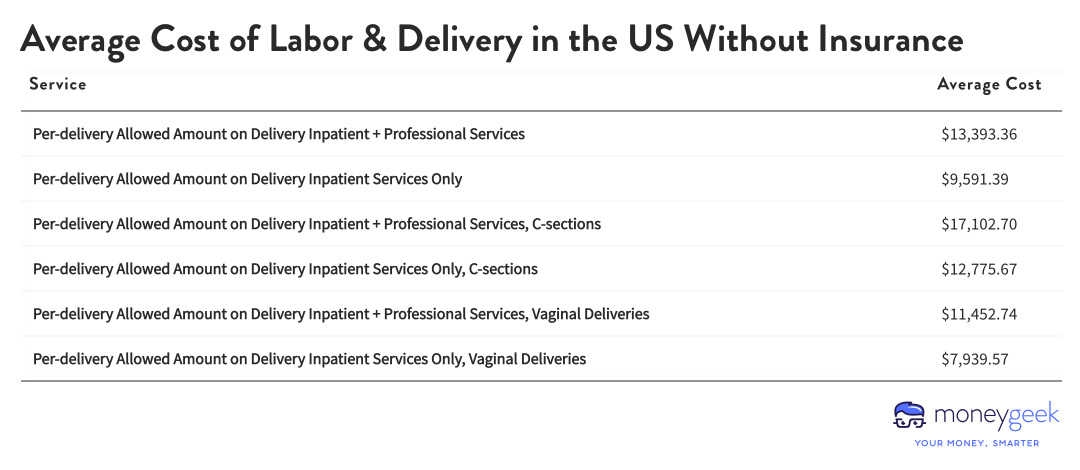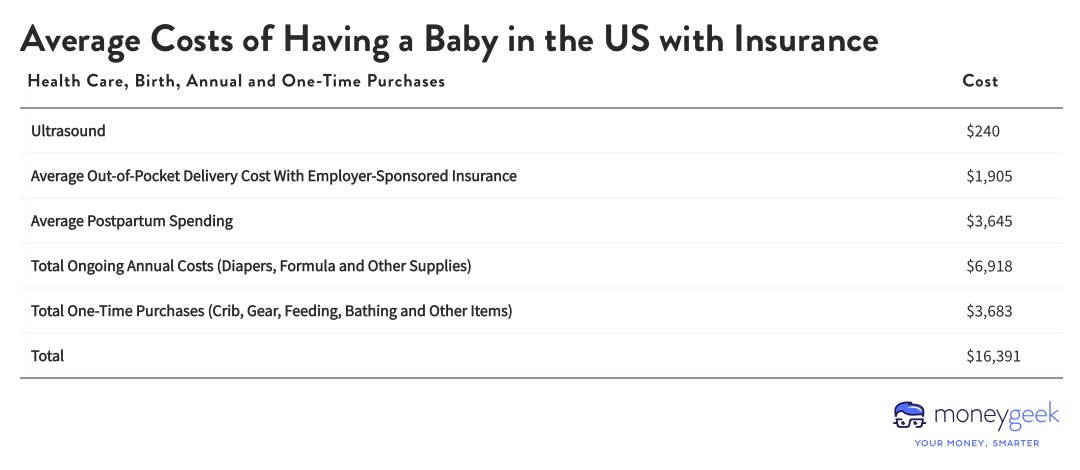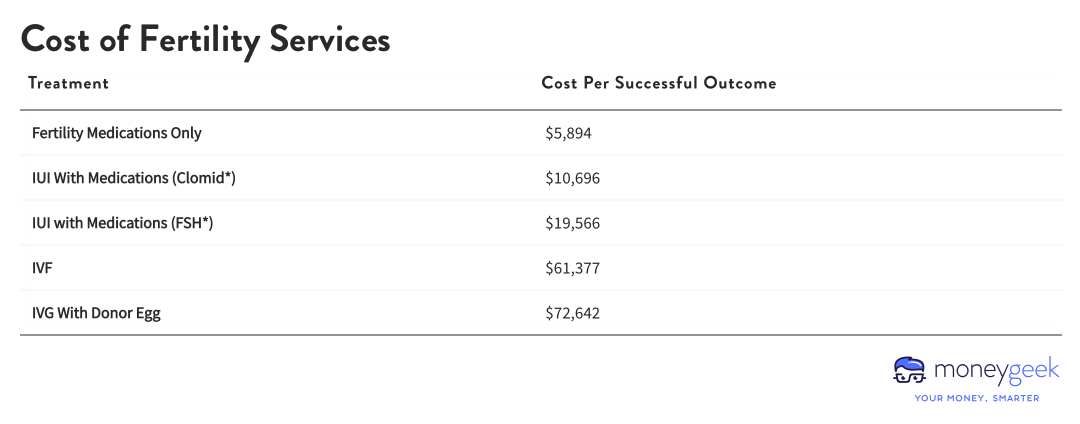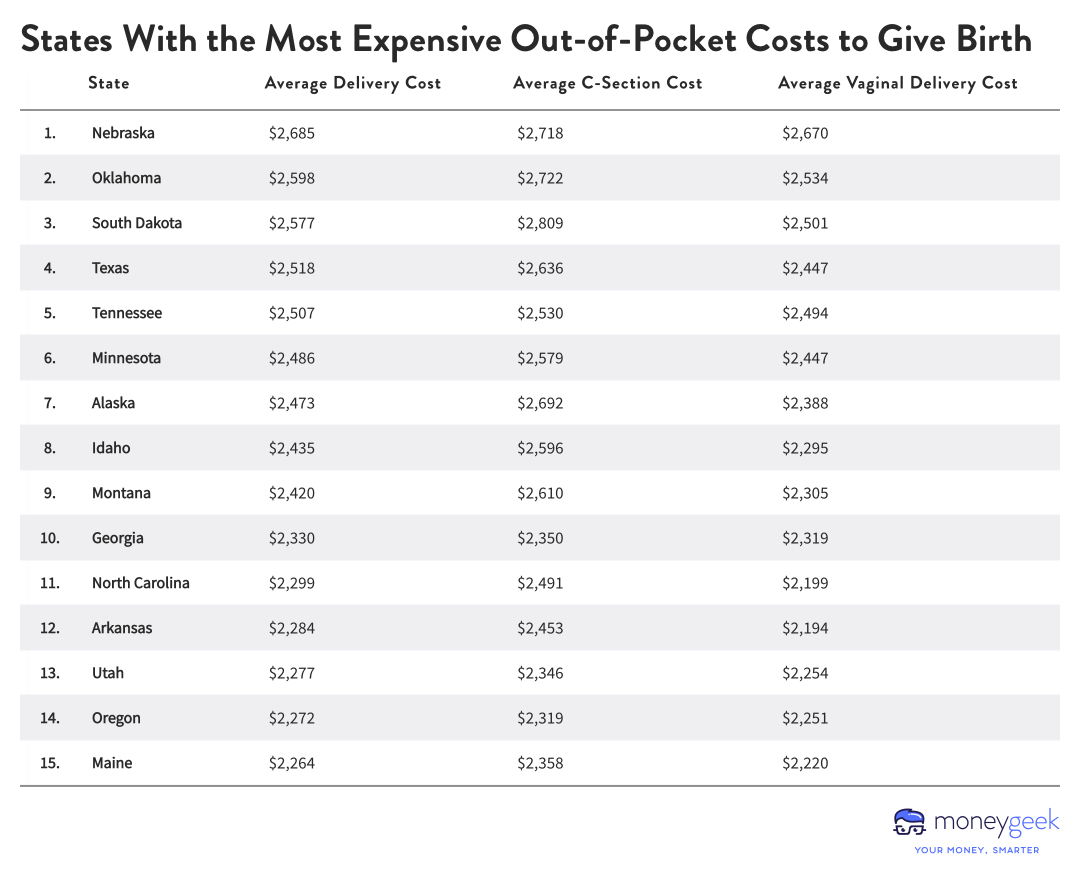The average cost of giving birth in the US

Canva
The average cost of giving birth in the US
A pregnant woman lies comfortably in a bed.
In the United States, the average cost of giving birth is approximately $1,900 with employer-sponsored health insurance and $14,000 without health insurance. MoneyGeek‘s analysis of data from government, academic, and nonprofit sources found that the cost of childbirth varies widely depending on where you live, but one thing is clear: having a baby in the U.S. — with or without health insurance coverage — is expensive.
Key Findings:
- Starting a family isn’t just a major life change — it’s also a serious financial investment. How much it costs to have a baby varies widely based on whether or not you have health insurance and where you live. And delivering a baby is just the beginning; the cost of supplies for a baby’s first year of life can also add up.
- On average, it costs $1,905 to give birth for those with employer-sponsored insurance and around $14,000 without coverage.
- Baby formula, diapers, nursery items and other supplies cost parents over $10,000 in the first year.
- Inflation will hit new families hard financially: baby supplies cost nearly $1,000 more in 2022 than they did in 2021.
- The cost of having a baby can range from about $6,000 to $73,000 for families using fertility services, based on the amount spent to yield successful outcomes.
- Nebraska, Oklahoma, South Dakota, Texas and Tennessee have the highest out-of-pocket costs for giving birth in the U.S.
![]()

MoneyGeek
Cost of Childbirth With Insurance in 2022
Chart showing the average cost of childbirth in the U.S. with insurance.
According to the Centers for Disease Control and Prevention (CDC), there were more than 3.7 million births in the U.S. in 2021, up 1% from 2020 — the first increase since 2014. Most babies are delivered vaginally, but Cesarean sections (C-sections) are also popular; in 2021, one-third (32%) of babies were delivered by C-section.
Even with health insurance, the average cost of delivery is $1,166, though it costs more for C-sections and less for vaginal deliveries. That figure typically only includes hospital charges.
Professional charges, such as those for services provided by other specialists and support staff during a hospital stay, are also involved in nearly every birth. Altogether, the average hospital bill for delivery, based on the out-of-pocket cost of childbirth, is close to $2,000.

MoneyGeek
How Much Labor & Delivery Costs Without Insurance
Chart showing the average cost of labor and delivery in the U.S. without insurance.
In the U.S., delivery costs without health insurance average nearly $10,000. Add in professional services, and medical expenses jump to more than $13,000. Giving birth via a C-section is even more expensive.
Being pregnant may count as a qualifying life event that triggers a Special Enrollment Period when you can sign up for health insurance on the state health insurance marketplace, even if open enrollment is over. Pregnancy and childbirth (and adoption) are also usually considered qualifying events for employer-sponsored insurance, which means that you may be able to get covered through your job or your spouse’s job, even if you opted out in the past. Or, if you’re unhappy with the coverage you chose, a qualifying event allows you to switch plans.
Depending on your income and location, you might qualify for Medicaid during and after pregnancy. If not, there may be low-cost health insurance options and free care or financial assistance through your local health department or community-based health care providers.
People without health insurance during pregnancy may still be able to sign up within 60 days of giving birth. Medicaid will cover new moms who qualify for at least 60 days after the birth, longer in some states with extended coverage for up to 12 months post-delivery.
Even if you can’t get coverage before your baby is born, getting coverage for yourself and your baby after birth can still help reduce your expenses for any care you and your baby need.

MoneyGeek
Total First-Year Average Costs to Have a Baby With Insurance
Chart showing the average costs of having a baby in the U.S. with insurance.
Childbirth costs may be overwhelming, but the expenses of having a baby don’t end (or begin) at delivery. MoneyGeek found that, with insurance, the average cost of health care, birth and essential purchases for a newborn amount to $17,115 when adjusted for inflation.
Though the Affordable Care Act (ACA) requires certain services to be covered under private health insurance — including pregnancy, childbirth and newborn care, which are considered Essential Health Benefits — there can also be additional health-related out-of-pocket costs that aren’t deemed medically necessary and thus aren’t covered, like ultrasounds. Under the ACA, prenatal visits, childbirth and well-baby visits must be covered under Medicaid and qualified health plans offered through the health insurance marketplace.
However, the ACA doesn’t help with most of the supplies new parents need, such as diapers, wipes and formula (though, if the baby needs specialty formula for medical reasons, some plans will cover it). Some health plans offer free or discounted products such as car seats or breast pumps, but these extra benefits are optional and not included with all plans.

MoneyGeek
Cost of Fertility Services
Chart showing the cost of facility services.
The cost of fertility services can make having a baby even more expensive.
Approximately 10 to 15% of heterosexual couples experience infertility, defined as the inability to get pregnant after trying for one year. Infertility may be caused by factors affecting either male or female partners, including sperm quality or motility, hormonal factors, ovulation issues or structural problems with the woman’s uterus or fallopian tubes. Same-sex couples or single individuals who want to have children may also use fertility services to achieve a pregnancy.
There are three main types of treatments for infertility, each with different typical price tags:
- Medications that stimulate ovulation.
- Surgical procedures to repair blocked or scarred fallopian tubes, remove cysts or fibroids from the uterus or extract sperm.
- Assisted conception, including intrauterine insemination (IUI), which inserts sperm into the uterus, or in vitro ferritization (IVF), in which an egg is fertilized outside the body and inserted into the womb.
The cost per successful outcome, or the cost to achieve a successful pregnancy, ranges from just under $6,000 for medications alone to more than $70,000 for IVF with a donor egg.

MoneyGeek
The Average Out-of-Pocket Cost of Giving Birth by State
Chart showing states with the most expensive out-of-pocket costs to give birth.
Where you live is a critical factor in how much it costs to have a baby. In Nebraska, for example, the average delivery with professional services costs nearly $2,700; that’s 36% higher than the national average of just under $2,000. And that’s with health insurance. On the low end, delivery costs less than $1,000 in Michigan, about half the national average.
In addition to costs, coverage for certain benefits during pregnancy — such as home visits, genetic screenings, dental care and diabetes monitoring supplies — also varies by state, according to the Kaiser Family Foundation. Perhaps not surprisingly, birth outcomes vary as well. Infant mortality rates, for example, range from more than eight deaths per 1,000 live births in Mississippi to 0 in Vermont.

Canva
How Health Insurance Covers Childbirth Costs
A pregnant woman sits on the floor taking notes in a book.
Before the ACA was implemented in 2014, it was legal to charge women higher health insurance premiums than men, which the National Women’s Law Center estimated cost women $1 billion per year. Additionally, most health insurance plans did not cover maternity care.
Once the ACA was enacted, new consumer protections prohibited health insurers from setting different rates based on gender. The ACA also mandated that pregnancy, childbirth and newborn services be covered as essential health benefits.
Additionally, certain services must be covered without out-of-pocket costs for consumers because they’re considered preventive. These services include prenatal visits and screening, folic acid supplements, counseling and intervention for tobacco cessation. These services aren’t included in the analysis, which focuses on direct out-of-pocket expenses.

Canva
Methodology
A pregnant woman in a hospital delivery room.
MoneyGeek analyzed data from the Health Care Cost Institute to find the average cost of delivery and services for those with employer-sponsored insurance, as well as the raw cost of services. This data assumes there are no complications with pregnancy or childbirth. Data for Alabama, North Dakota and Wyoming were not available.
The analysis also used cost estimates for ongoing and one-time purchases from Babycenter.com to find additional average costs associated with having a baby, such as formula, diapers and other supplies. The analysis used the Consumer Price Index’s inflation rate to adjust these consumer costs to the current inflation rate (9.1%).
And the analysis utilized data from the Health Care Cost Institute to assess average postpartum spending and the Kaiser Family Foundation to analyze fertility costs.
Please note: “Delivery” and “Delivery & Professional Services” costs are averages of the following in each instance mentioned:
- Delivery: Average of C-section and vaginal delivery costs
- Delivery & Professional Services: Average of C-section and professional services costs and vaginal delivery and professional services costs.
This story was produced by MoneyGeek and reviewed and distributed by Stacker Media.
